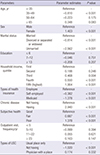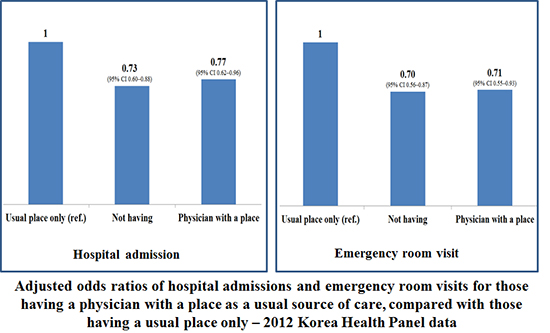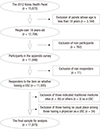2. Damiano PC, Momany ET, Tyler MC, Penziner AJ, Lobas JG. Cost of outpatient medical care for children and youth with special health care needs: investigating the impact of the medical home. Pediatrics. 2006; 118:e1187–94.
3. Starfield B, Shi L. The medical home, access to care, and insurance: a review of evidence. Pediatrics. 2004; 113:1493–1498.
4. Smith PJ, Santoli JM, Chu SY, Ochoa DQ, Rodewald LE. The association between having a medical home and vaccination coverage among children eligible for the vaccines for children program. Pediatrics. 2005; 116:130–139.
5. Xu KT. Usual source of care in preventive service use: a regular doctor versus a regular site. Health Serv Res. 2002; 37:1509–1529.
6. Du Z, Liao Y, Chen CC, Hao Y, Hu R. Usual source of care and the quality of primary care: a survey of patients in Guangdong province, China. Int J Equity Health. 2015; 14:60.
7. Friedberg MW, Hussey PS, Schneider EC. Primary care: a critical review of the evidence on quality and costs of health care. Health Aff (Millwood). 2010; 29:766–772.
8. Starfield B, Shi L, Macinko J. Contribution of primary care to health systems and health. Milbank Q. 2005; 83:457–502.
9. Alpert JJ, Kosa J, Haggerty RJ, Robertson LS, Heagarty MC. Attitudes and satisfactions of low-income families receiving comprehensive pediatric care. Am J Public Health Nations Health. 1970; 60:499–506.
10. Becker MH, Drachman RH, Kirscht JP. Continuity of pediatrician: new support for an old shibboleth. J Pediatr. 1974; 84:599–605.
11. Dietrich AJ, Marton KI. Does continuous care from a physician make a difference? J Fam Pract. 1982; 15:929–937.
12. Starfield B. Primary Care: Concept, Evaluation, and Policy. New York, NY: Oxford University Press;1992.
13. Lambrew JM, DeFriese GH, Carey TS, Ricketts TC, Biddle AK. The effects of having a regular doctor on access to primary care. Med Care. 1996; 34:138–151.
14. Stewart AL, Grumbach K, Osmond DH, Vranizan K, Komaromy M, Bindman AB. Primary care and patient perceptions of access to care. J Fam Pract. 1997; 44:177–185.
15. Ahn SH. Assessment of primary care level in Korea and comparison with the developed countries. J Korean Acad Fam Med. 2001; 22:483–497.
16. Kwon S, Lee TJ, Kim CY. Republic of Korea Health System Review: Health Systems in Transition, vol. 5 no. 4. Geneva: World Health Organization;2015.
18. Kim JH, Cho HJ. Effects of having regular source of care on preventive services and disease control. J Korean Acad Fam Med. 2007; 28:278–285.
19. Schoen C, Osborn R, Doty MM, Bishop M, Peugh J, Murukutla N. Toward higher-performance health systems: adults’ health care experiences in seven countries, 2007. Health Aff (Millwood). 2007; 26:w717–34.
20. Lee JH, Sung NJ, An AR, Lee SI, Hyun MK. Current status of having a usual source of care and its related medical costs in Korean adults: a study of the 2012 Korea health panel survey. In : The 7th Korea Health Panel Conference; 2015 Nov 26; Seoul. Sejong: Korea Institute for Health and Social Affairs;2015.
21. Austin PC, Steyerberg EW. Interpreting the concordance statistic of a logistic regression model: relation to the variance and odds ratio of a continuous explanatory variable. BMC Med Res Methodol. 2012; 12:82.
22. Pencina MJ, D’Agostino RB Sr. Evaluating discrimination of risk prediction models: the C statistic. JAMA. 2015; 314:1063–1064.
23. Lee JY, Jo MW, Yoo WS, Kim HJ, Eun SJ. Evidence of a broken healthcare delivery system in Korea: unnecessary hospital outpatient utilization among patients with a single chronic disease without complications. J Korean Med Sci. 2014; 29:1590–1596.
24. Ministry of Health and Welfare (Korea). Regulation for Criteria for Providing Reimbursed Services in the National Health Insurance. Article 2: Processes of Providing Reimbursed Services - Paragraph 4. (Amended on 31 July 2009, 23 December 2010) [Internet]. accessed on 13 Nov 2016. Available at
http://www.law.go.kr/lsInfoP.do?urlMode=lsInfoP&lsId=006697#0000.
26. Gill JM, Mainous AG 3rd. The role of provider continuity in preventing hospitalizations. Arch Fam Med. 1998; 7:352–357.
28. Fung CS, Wong CK, Fong DY, Lee A, Lam CL. Having a family doctor was associated with lower utilization of hospital-based health services. BMC Health Serv Res. 2015; 15:42.
29. Harrison MJ, Dusheiko M, Sutton M, Gravelle H, Doran T, Roland M. Effect of a national primary care pay for performance scheme on emergency hospital admissions for ambulatory care sensitive conditions: controlled longitudinal study. BMJ. 2014; 349:g6423.
30. Weiss LJ, Blustein J. Faithful patients: the effect of long-term physician-patient relationships on the costs and use of health care by older Americans. Am J Public Health. 1996; 86:1742–1747.








 PDF
PDF ePub
ePub Citation
Citation Print
Print





 XML Download
XML Download